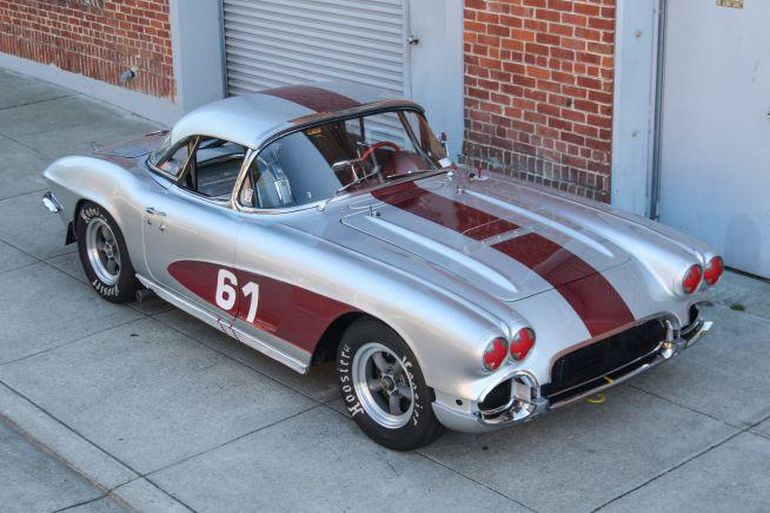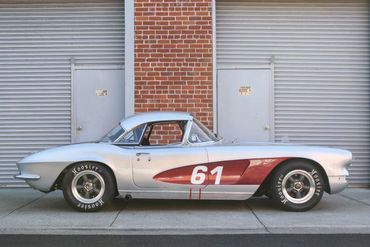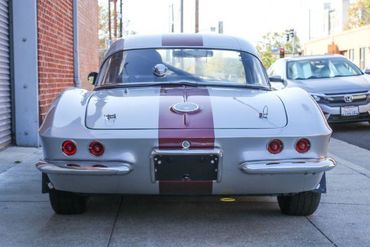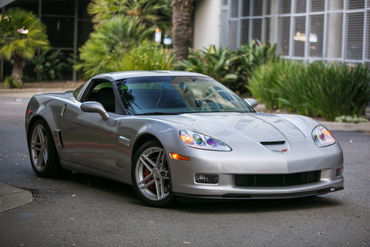Sold
SOLD 02/19
1962 Chevrolet
Corvette
C1 Race Car Comprehensively Built to High Standards with Excellent Attention to Detail. Top Quality Components Throughout Including Riveted Fuel Tank. FIA Papers, 2018 Monterey Historics Participant.
- VIN20867S110157
- Exterior ColorSilver with Red Coves
- Interior ColorRed
- Mileage1885 Miles
- Engine331 ci V8
- Transmission4-Speed Manual
- StatusSold
- StockFJ2281
Description
1962 Chevrolet Corvette Racecar
s/n 20867S110157
Silver Metallic with Red Coves and Red Interior
Introduced in 1953 as the production version of the popular Motorama show car, the new Corvette sports car was a big gamble for Chevrolet, General Motor’s largest and most profitable division. Considered the more conservative line, Chevrolet executives were hesitant to launch such a car. Initial sales proved to be less than stellar (just 300 units sold of the in-line six cylinder boulevardier), but sales increased dramatically after a couple years of production thanks to the introduction of a V8 powerplant. By 1960, the Chevrolet Corvette was thoroughly reworked with remarkably improved performance and handling, delivering sales in excess of 10,000 units per year.
Under the watchful eye of celebrated General Motors engineer Zora Arkus-Duntov, the Corvette evolved from the mild-mannered cruiser of its earlier years to a robust track-oriented performance automobile. Power derived from a host of small-block V8s with power outputs ranging from 230 to 315 horsepower, peaked with the fuel-injected 327 engine. By 1962, the final year of the C1 solid-axle series Corvette, the body design had changed dramatically, hinting at the crisp angular rear styling that would appear in the C2 Sting Ray. Uniquely designed for 1962, the rear section of the Corvette features the new rear body treatment with linear body architecture, quad taillights (a feature still in use today), joined to the iconic 1950s recessed cove body side sections and quad headlights. The resultant car hinted at European designs but with powerful American stance, packing substantially more horsepower than competitors. The 1962 Corvette would be the last of the C1 solid axle cars before the new Stingray came to market. Still considered one of the hallmarks of the Duntov era, the C1 Corvette remains among the more sought after performance cars of this period.
This particular 1962 Corvette was restored to honor the spirit of Le Mans, where a Corvette raced in 1962. The livery and configuration is also in tribute to west coast racing pioneer John von Neumann. Details featured in the restoration include the Plexiglas hood mounted bug deflector, the racing running lights, and most importantly (one of the most expensive details), the custom fabricated riveted fuel tank, created in the same manner the original bespoke Italian tank fitted in the 1962 racing car. This tank was constructed to contemporary safety standards containing a safety fuel cell. This highly developed racecar represents a fantastic opportunity for anyone seeking a well-engineered vehicle built for performance and racing durability, as evidenced by the nearly $200,000 spent in restoration and preparation for vintage events. In addition to the fine workmanship and carefully selected components on the car, it is tastefully executed while being updated for performance use. In addition to the remarkable workmanship, FIA papers, SVRA Gold Medallion Log Book, and HMSA Vehicle Inspection Log Book (from 2017) accompany the car. With these documents, the next owner can confidently consider European racing events like the Le Mans Classic and other limited entry touring or road circuit races in addition to other US-based vintage events.
The current engine in the car was built by experts at Ron Shaver’s engine shop (Corvette engine specialists for decades) and has logged only three weekends since it was completed and tested. It is a 327 cubic inch engine that has been bored over to 331 cid. During the build, the engine was carefully assembled and prepared running a single four-barrel carburetor, 11 quart Acusump wet sump oil system (located in the trunk), Tilton Super Starter, and GM dual point ignition, to name just a few of the top level components used in the build. The engine was tested in January 2018, putting out a whopping 484 hp with 404 lb. ft. torque as documented in the notebook showing dyno results, charts, and performance numbers. This well-developed engine is mated to a T10 Tex Powell Super Close Ratio transmission with a Tilton 7 ¼” three plate clutch. Ford rear axles and bearings have been installed with Ford brakes on the rear CM center. In addition to the engine work performed on the car, the current owner purchased an original Rochester fuel injection unit when researching the potential use for racing. The fuel-injection unit is accompanied by detailed hand written notations, diagrams, and specifications for competition preparation from noted vintage FI expert Chris Wikersham. This original 1957-1961 unit is included with the sale.
In addition to the extensive engine and transmission work specifically performed on the car for race use, the suspension has been significantly improved using extremely rare and desirable big block springs, larger front sway bar, and Bilstein shocks. The car has been lowered 2 inches for better handling and lower center of gravity. From the first stages of restoration, the entire car has been exceptionally well-conceived, developed, and refined for performance on the track. At every juncture, leading experts in the Corvette performance industry were consulted to make this car one of the most durable and capable performers in its class.
The exterior finish has been completed to a high standard in silver metallic with red coves and matching red center body stripe. The car has very good vintage racer cosmetics with minimal paint flaws, though minor marks are present on the front of the car from use. The high gloss finish accents nicely against finished chrome trim completing the vintage look of the car. The front bumper and grille insert has been removed to save weight, but the lighter weight grille trim and side intake trim have been retained to convey the distinctive C1 Corvette aesthetic. The car is shod with Hoosier racing tires and wide period correct cast wheels with polished rims, which have been documented with detailed notes on adjustment and suspension settings. The stance and look of the car retains a vintage appearance, while conveying a clearly menacing and hunkered down presence. A transparent Plexiglas bug deflector is installed mid-length of the hood flanked on the driver’s side front fender by a red safety fuel cut-off switch and black electrical shut off lever. There is also a transponder located on the left front inner fender panel and a booster plug located on the right front inner fender, as well as a proportioning valve located on the right frame rail under the passenger seat. The driver’s side of the windshield boasts just a few of the recent events the car has participated in, including the 2016 Laguna Seca Pre-Reunion, 2017 60 year Laguna Seca Raceway event, 2018 Rolex Monterey Motorsports Reunion, and 2018 Sonoma Historics. These stickers are also accompanied by multiple race log sheets showing lap times during each of the sessions.
Inside the cockpit, the stock red Corvette dashboard remains with additional red interior features. The chrome perimeter trim for seating and cockpit details further convey the vintage Corvette charm and performance features of the past. An up to date racing seat has been installed with excellent side support, contemporary five-point restraint, and fire suppression system. A factory Corvette steering wheel is in place, wrapped in red material for thicker grip. Overall the interior has a strong, purposeful look with excellent vintage touches, including the instruments, so that the interior does not appear excessively modernized.
Under the hood, the Shaver-built engine is clean, easily accessible, and fitted with both period correct Chevrolet features and contemporary racing upgrades. While not detailed for show, the engine and engine compartment have a nice vintage feel to the components and finishes are consistent with the exterior, reflective of the high quality construction throughout the car.
The car is accompanied by a set of spare wheels and tires, a large plastic tub of spares, three other boxes of spare parts, and (although this car was not an original FI factory spec car) an original Fuel Injection unit (Rochester Products Serial No. 2117) and intake ducting with the shielding and air plenum, including notations from expert Chris Wickersham. Also included is a spare clutch, spare crank, a set of racing rods, an original type generator, extra rear leaf springs, a set of original type exhaust manifolds, a spare set of drum brakes and finned castings, and an original type cooling fan. Documents include dyno sheet test result charts, race logs, inspection book, and reference literature for many of the components installed in the car.
This is an excellent opportunity to acquire a nicely prepared vintage Corvette, suitable for many important events both nationally and, with FIA papers, internationally. The combined contemporary engineering and vintage artistry developed in this recently prepared competition car result in a robust and handsome performance icon of the past, ready for exciting events to come.
The above vehicle information is complete and accurate to the best of our knowledge at the time it is posted to this website. Corrections or additional information is always appreciated. All advertised prices exclude government fees and taxes, any finance charges, any dealer document preparation charge, and any emission testing charge. Vehicles are subject to prior sale. All advertised to be true but not guaranteed. We assume no liability for errors or omissions.
Inquire About This Car
Fantasy Junction • 510-653-7555 • 1145 Park Ave, Emeryville, CA 94608




